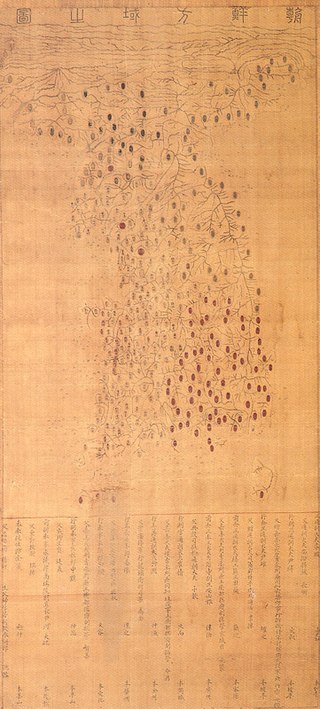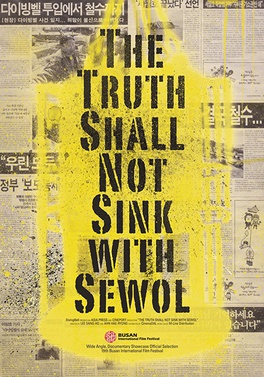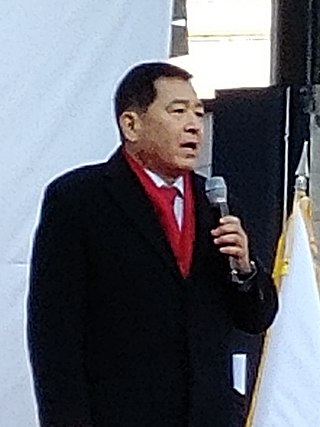
The history of South Korea begins with the Japanese surrender on 2 September 1945. At that time, South Korea and North Korea were divided, despite being the same people and on the same peninsula. In 1950, the Korean War broke out. North Korea overran South Korea until US-lead UN forces intervened. At the end of the war in 1953, the border between South and North remained largely similar. Tensions between the two sides continued. South Korea alternated between dictatorship and liberal democracy. It underwent substantial economic development.
The yellow ribbon is used for various purposes. It may be worn on a person, placed on a vehicle, around a tree, or for a neck tie.

Park Geun-hye is a South Korean politician who served as the 11th president of South Korea from 2013 to 2017, when she was impeached and convicted on related corruption charges.

Jung Hong-won is a former Prime Minister of South Korea. He served from 26 February 2013 to 16 February 2015 under conservative President Park Geun-hye. Jung was a member of the Saenuri Party.
Events in the year 2014 in South Korea.

The ferry MV Sewol sank on the morning of April 16, 2014, en route from Incheon towards Jeju in South Korea. The 6,825-ton vessel sent a distress signal from about 2.7 kilometres north of Byeongpungdo at 08:58 KST. Out of 476 passengers and crew, 306 died in the disaster, including around 250 students from Danwon High School in Ansan City. Of the approximately 170 survivors, more than half were rescued by fishing boats and other commercial vessels that arrived at the scene approximately 40 minutes before the Korea Coast Guard (KCG).
The South Korean ferry Seohae sank on October 10, 1993 in the Yellow Sea near Wido, Buan County, North Jeolla Province. 292 of the 362 passengers and crew on board were killed. 70 people were rescued.

MV Sewol was a South Korean vehicle-passenger ferry, built and previously operated in Japan. She operated between Incheon and Jeju. On 16 April 2014, Sewol capsized and sank with the loss of 304 passengers and crew.
Yoo Byung-eun was a South Korean businessman, inventor, religious leader, and photographer. He was also known by his art name Ahae.
The Evangelical Baptist Church (EBC) of Korea, was established in 1962 by Yoo Byung-eun and Pastor Kwon Shin-chan. The name of the church was changed to EBC in 1981. It is not connected to the Korea Baptist Convention. In South Korea, EBC is commonly known as Guwonpa, meaning Salvation Sect, from the Korean term guwon (구원), "salvation".

The Truth Shall Not Sink with Sewol is a South Korean documentary film about the sinking of the MV Sewol, directed by Lee Sang-ho and Ahn Hae-ryong. The documentary draws back the curtain on one of the most controversial parts of modern Korean history, the aftermath of the sinking of the MV Sewol, which resulted in the loss of 304 people. Through a variety of news reports and eyewitness testimonies, directors Lee Sang-ho and Ahn Hae-ryong show how the large South Korean media companies colluded with the government over the information about the sinking of the ferry. He highlights the suffering of the victims’ families, their quest to discover the cause of the accident, and the truth behind the government’s behavior during and after it. The documentary focuses on the use of a diving bell, a piece of equipment that allows divers to stay underwater for long periods of time.

Yong Hye-in is a South Korean civil society activist and leader of the Basic Income Party. She was one of the main proponents of the silent march campaign, Stay Where You Are, that originated in an announcement made during the Sinking of MV Sewol in 2014.

The 2016 South Korean political scandal, often called Park Geun-hye–Choi Soon-sil Gate in South Korea, was a scandal that emerged around October 2016 in relation to the unusual access that Choi Soon-sil, the daughter of shaman-esque cult leader Choi Tae-min, had to President Park Geun-hye of South Korea.

The 2016–2017 South Korean protests or the Candlelight Demonstrations, also known as the Candlelight Vigil, were a series of protests against President Park Geun-hye that occurred throughout South Korea from November 2016 to March 2017. Protesters denounced the Park administration's 2016 political scandal and called for the resignation of Park Geun-hye.

The impeachment of Park Geun-hye, President of South Korea, was the culmination of a political scandal involving interventions to the presidency from her aide, Choi Soon-sil. The impeachment vote took place on 9 December 2016, with 234 members of the 300-member National Assembly voting in favour of the impeachment and temporary suspension of Park Geun-hye's presidential powers and duties. This exceeded the required two-thirds threshold in the National Assembly and, although the vote was by secret ballot, the results indicated that more than half of the 128 lawmakers in Park's party Saenuri had supported her impeachment. Thus, Hwang Kyo-ahn, then Prime Minister of South Korea, became Acting President while the Constitutional Court of Korea was due to determine whether to accept the impeachment. The court upheld the impeachment in a unanimous 8–0 decision on 10 March 2017, removing Park from office. The regularly scheduled presidential election was advanced to 9 May 2017, and Moon Jae-in, former leader of the Democratic Party, was elected as Park's permanent successor.

Shim Jae-chul is a South Korean journalist and politician. He is a current member of the National Assembly and the Floor Leader of the United Future Party.

Intention is a 2018 documentary film directed by Ji-young Kim, who also directed the follow-up investigation, Ghost Ship. The film focuses on the South Korean government's involvement in and cover up of the Sewol ferry disaster in 2014. It features scientific analyses and testimonies from survivors to reveal the cause of the sinking, which resulted in the deaths of 304 of the 476 people on board, most of whom were high school students. Kim proves that much of the government-released data made available to the public was faked. Survivors indicated that there was governmental pressure to change their testimonies about the sinking to fit a different, inaccurate narrative for the disaster. Kim proves that there was collusion between government entities to not only conceal that the ship's sinking was not accidental, but also cover up the fact that the Korean Coast Guard failed to rescue passengers.Intention reveals the corruption within the government of Park Geun-Hye, the South Korean president who was impeached in 2017, and notably focuses attention on the National Intelligence Service (NIS). The film is narrated by actor Jung Woo-sung.

The Taegeukgi rallies, also known as the Pro-Park rallies, are ongoing rallies that initially started as a series of counter-candlelight rallies supporting the former president of South Korea Park Geun-hye in 2016 but now continuing with the aim of releasing Park. The Taegeukgi protestors or the Taegeukgi crowds got their names because they vehemently swung or wore South Korean flags during rallies.

In the Absence (Korean: 부재의기억) is a 2018 South Korean–American short documentary film that depicts the sinking of the MV Sewol in 2014, in which three hundred people – mostly school children from Danwon High School – lost their lives.
In South Korea, the Candlelight rallies., also referred to as the Candlelight Struggle, Candlelight Revolution, or a candlelight cultural festival and is also attended with a humorous props and banner along with candles. Candlelight protests are symbolic collective gatherings of political dissent in South Korea to combat injustice peacefully. This method of protesting began in 1992 for opposing the charging of online service. After that in 2002, as a result of the Yangju highway incident, then utilized in the rallies against the impeachment of Roh Moo-hyun in 2004, re-used again in the 2008 U.S. beef protests, and emerged in the 2016-18 President Park Geun-hye protests.












